As I've been working on my upcoming second book, Healthcare Kaizen: Engaging Front-Line Staff in Sustainable Improvements, I've had “kaizen” (or continuous improvement) on the brain even more than usual.
One distinction between kaizen ideas and a traditional “suggestion system” is that, with kaizen, you maintain control of your own idea to see it through (with the help of your supervisor and others). You're not telling others what they should do, you're saying what you want to do (I appreciate Norman Bodek for making this distinction very clear over the past few years).
So how did I apply kaizen to my own desk and writing setup?
I recently bought an adjustable “stand up” desk for my home office. Buying a new desk does not really qualify as the best example of kaizen. Yes, I made a “change for the better” of my own initiative, but it involved spending money. The best kaizens are done by putting “creativity over capital.”
Here is a picture of my working setup for writing, blogging, and podcasting. That's a microphone to the left. Yes, that's indeed a bobblehead of Jim Womack. That was a gift I received at the celebration for Jim's departure as LEI CEO (no LEI isn't selling the bobbleheads – people have asked).
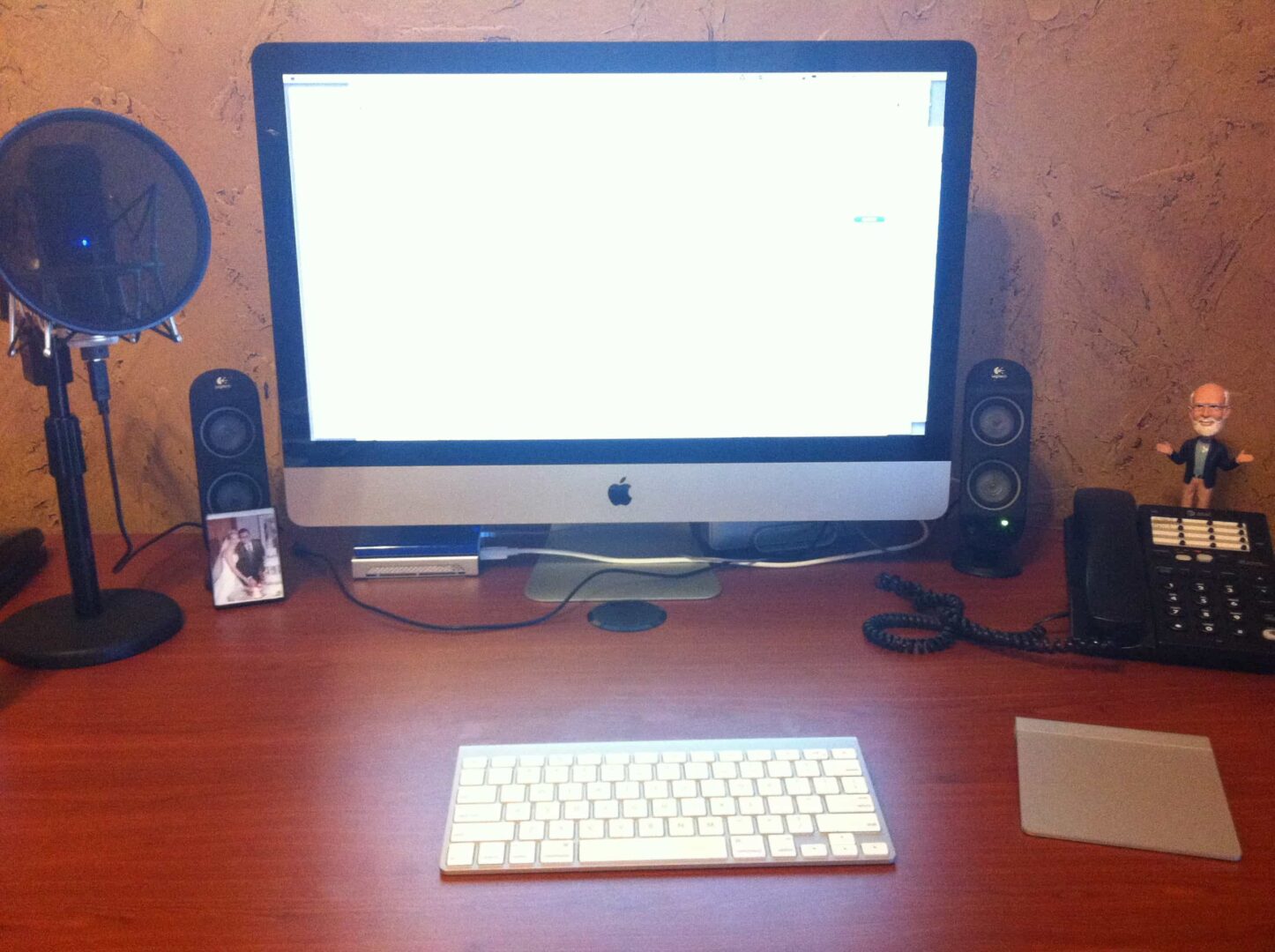
Anyway, back to the setup. This new desk as a laminate surface that's somewhat “slippery” compared to the old desk. The Mac bluetooth keyboard and trackpad
are relatively light. So, I found when I was typing or using the trackpad, they would tend to slide away from me a bit on the desk. The little rubber feet / pads on the bottom of the devices aren't quite “tacky” enough to grab onto the desk securely.
I was trying to think about how to solve this situation and I ordered a small desk pad that I could place under the keyboard and trackpad. This pad would also provide a good writing surface and it would protect the desk surface from damage. But again, buying something for $30 isn't the best form of kaizen. I would have been accused of being a “catalog engineer” by the originators of the Toyota Production System. There had to be a better way.
I didn't have anybody around, working in a home office, to brainstorm with – so I asked a question on Twitter:
I love my new stand up desk, but the danged Mac bluetooth keyboard is so light it slides around on desk when I type. #Kaizen = desk pad?
I got a response from Tobias Gilk:
“Weatherstripping tape… Neoprene foam with an adhesive backing.”
I misunderstood his idea, thinking he was suggesting that I tape the keyboard to the desk. He kindly clarified:
Apply little bits of the weatherstrip tape to the corners of the underside of the keyboard. The neoprene will ‘grippy' the desk.
Ah, now I see. This approach would keep the keyboard in place, but allow me to easily reposition or move it. But I didn't have any weatherstripping tape handy.
As often happens with kaizen, I built on Tobia's idea.
What I *did* have was some of that tacky putty stuff that you can use for hanging signs or posters. Since the underside of the Apple devices isn't really flat (which might have prevented tape from working?), I thought the putty was worth a try, as shown here:
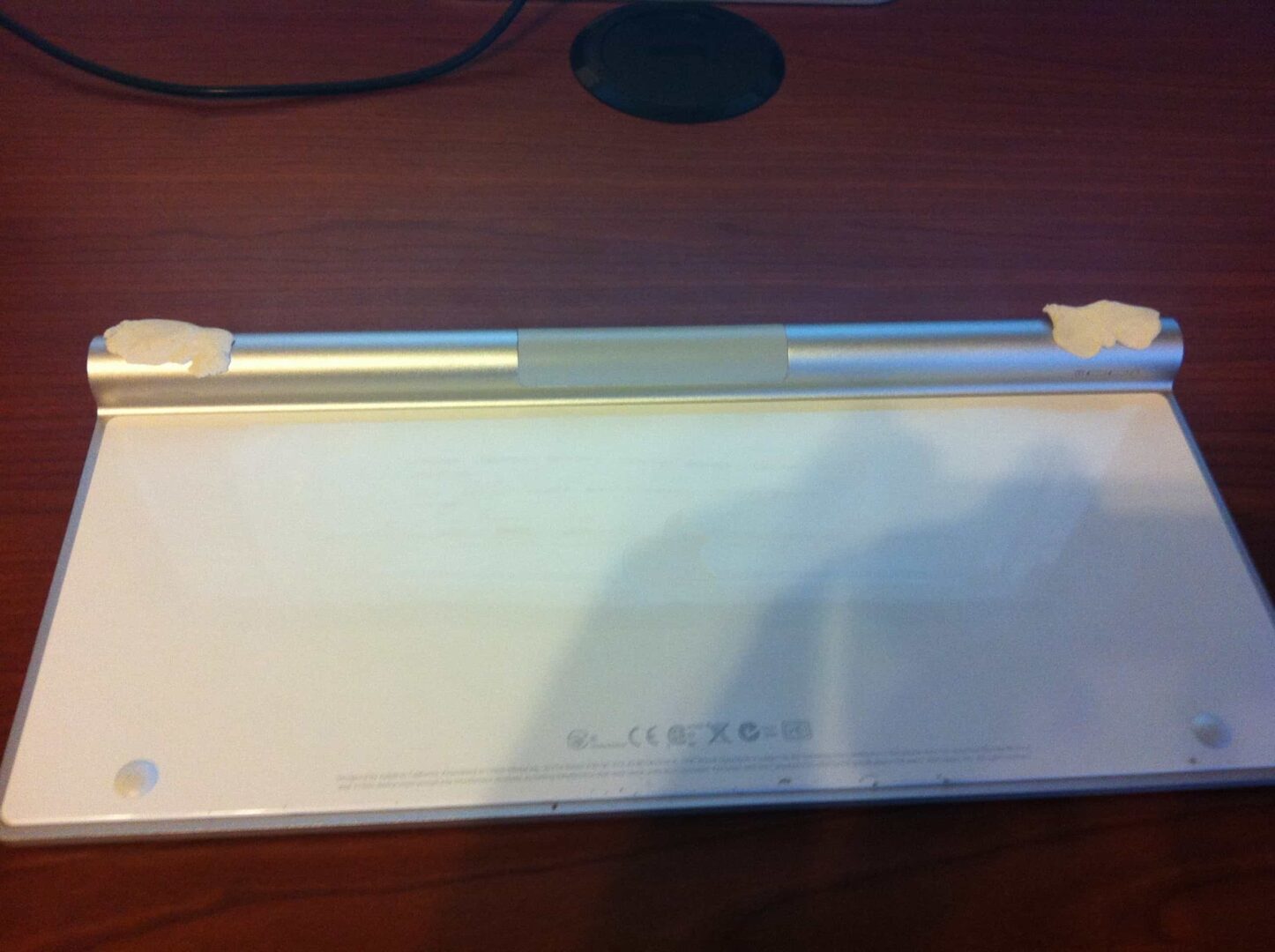
The putty molds to the bottom of the keyboard just perfectly. I tested it out… perfect! The keyboard was no longer sliding around. The putty created enough grip and friction, but didn't stick to the desk if I wanted to move the keyboard.
I repeated this with the trackpad:
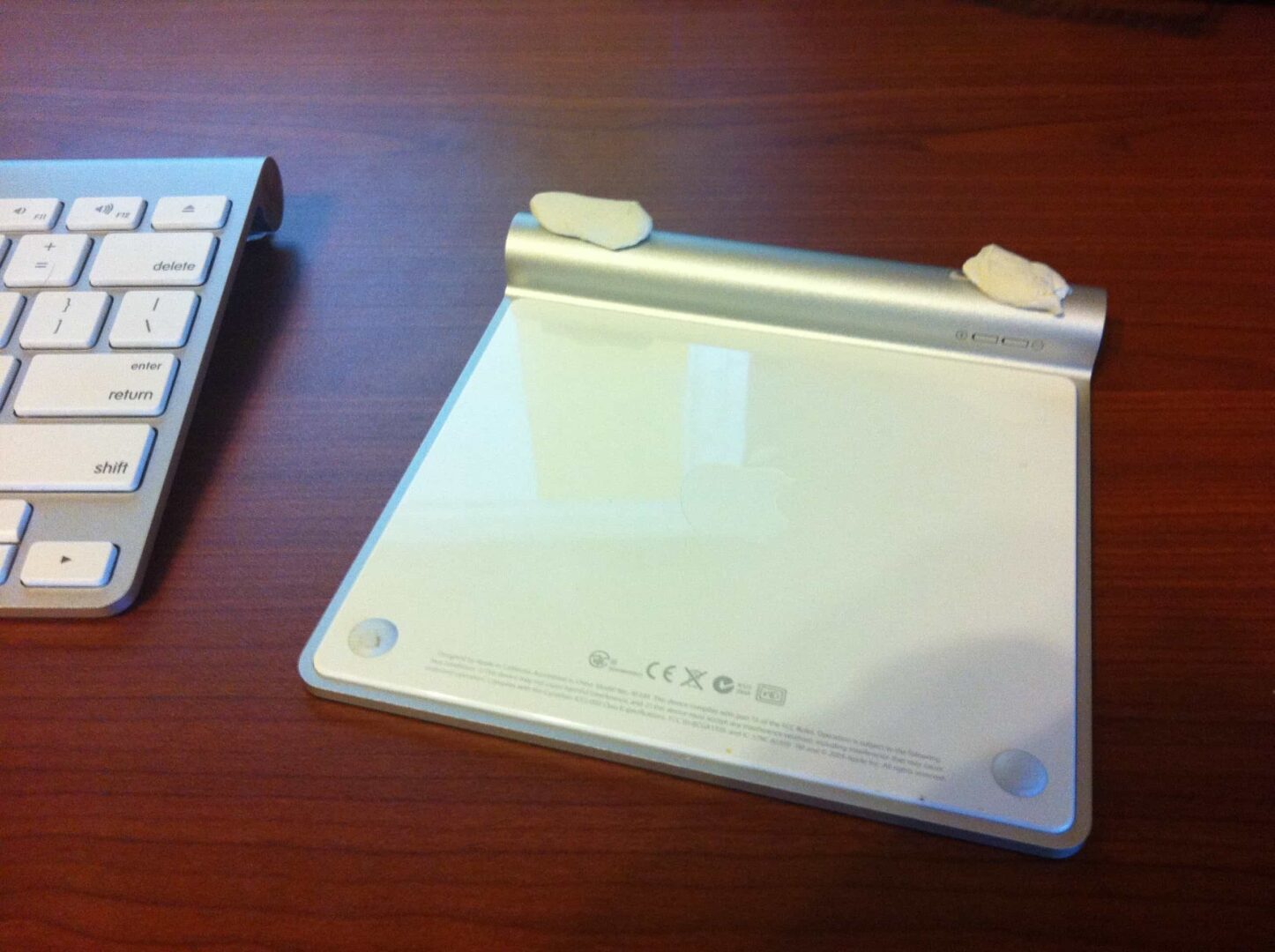
Now I'm questioning if I really need the desk pad!
I think this solution was “kaizen-y” because:
- I initiated it.
- It was solving a problem I was personally experiencing.
- The solution was “free” (I had already bought the putty for $3 or $4 and had extra).
- It was easy to test quickly without possible harm to the desk or devices.
- I drew on the ideas of others to spur more creative thinking.
In the style of Bodek's “Quick and Easy Kaizen,” I did a “Kaizen Report” in the style used by my co-author Joe Swartz and his health system:
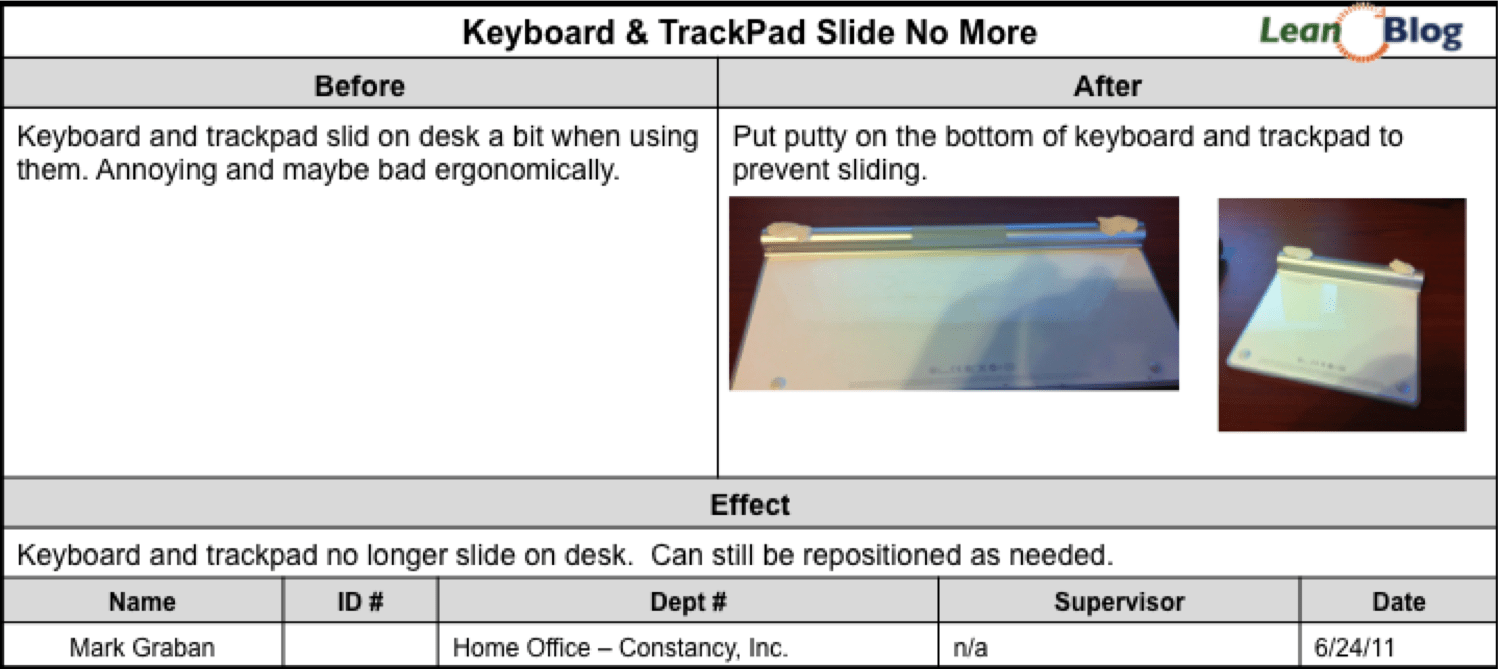
This took just a few minutes to write up. Were I in a larger workplace, these ideas could be shared in different ways, including an online databased that can searched (as Joe's health system has).
Everybody has the ability to identify and solve little problems like this in the workplace. That's kaizen. We don't always need to go run to a supervisor to get THEIR ideas, kaizen is about YOUR ideas. Now, granted, you'll talk to your supervisor or teammates and get ideas or even “approval” if the idea involves others, but this isn't a bureaucratic process with kaizen. Supervisors don't feel threatened when other people have ideas with kaizen.
Kaizen #2:
As often happens with kaizen, one idea leads to another (or one problem creates another problem). The “countermeasure” (as Lean people tend to say) of putting the putty under the top of the keyboard created a new situation where the front edge of the keyboard was rattling – bouncing just slightly on the desk. The keyboard wasn't sliding, but it was now louder.
Time for another kaizen!
I put some putty under the front edge of the keyboard. Problem solved!
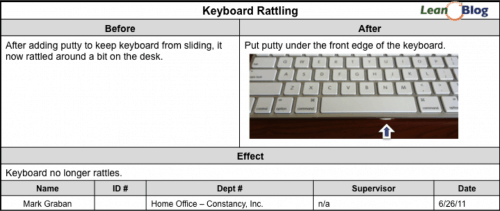
I hope this illustrates how kaizen doesn't have to mean a week-long “kaizen event.” As Mr. Imai said, kaizen is everybody making improvements everywhere, every day.
Do you have any examples of kaizen applied to your own individual work? Please leave a comment.
Please scroll down (or click) to post a comment. Connect with me on LinkedIn.
Let’s work together to build a culture of continuous improvement and psychological safety. If you're a leader looking to create lasting change—not just projects—I help organizations:
- Engage people at all levels in sustainable improvement
- Shift from fear of mistakes to learning from them
- Apply Lean thinking in practical, people-centered ways
Interested in coaching or a keynote talk? Let’s start a conversation.










From Facebook:
“Was your solution “kaizen-y” or “kai-zany”! (Truly, I’m sorry for this one)”
I think the Twitter idea is a better long term solution since it won’t squish out over time (putty will creep). You need to get the self-adhesive type of high-density foam weatherstripping that comes in a roll. You can cut 4 half to one inch long peices and stick them to the bottom of your keyboard. You’d probably want to get the thinnest weatherstripping you could find so that it’s not so “bouncy”. I was also thinking that you could just find a cheap foam rubber placemat to put under the keyboard and that way you won’t have to stick anything to your keyboard. Anyway, I like your kaizen quick fix!
I’ve applied similar thinking to hanging a flat screen TV on the wall. You know those “thin” mounts that cost $100 or more? Well, it turns out that may large peices of art weigh as much or more than your prized flat screen. You can just put a two lag screws into studs or appropriately sized wall anchors into the wall with fender washers spaced away from the wall by regular washers, then you can attach picture wire or braided steel cable (again, appropriately sized) to the mounting holes on the back of the TV, and then hang the whole shebang on the wall. Total cost of screws, washers and wire is about $20, and your TV will be as close to your wall as physically possible.
Thanks for the comment. The putty is working perfectly so far. I’m not putting that much weight on my keyboard, so the creeping isn’t too bad right now. That kaizen was the kaizen I could do that day with the materials I had around. We’ll see what happens over time.